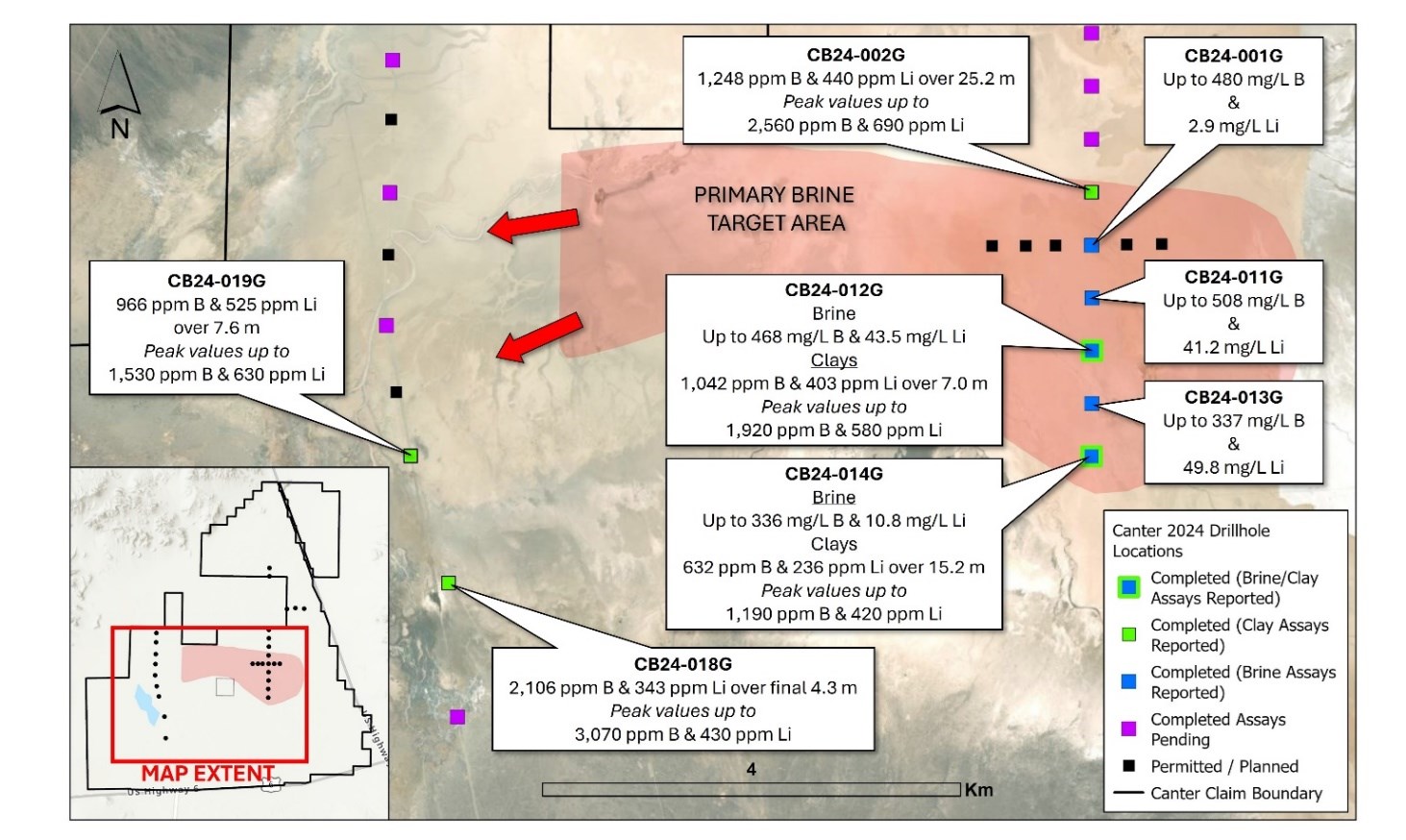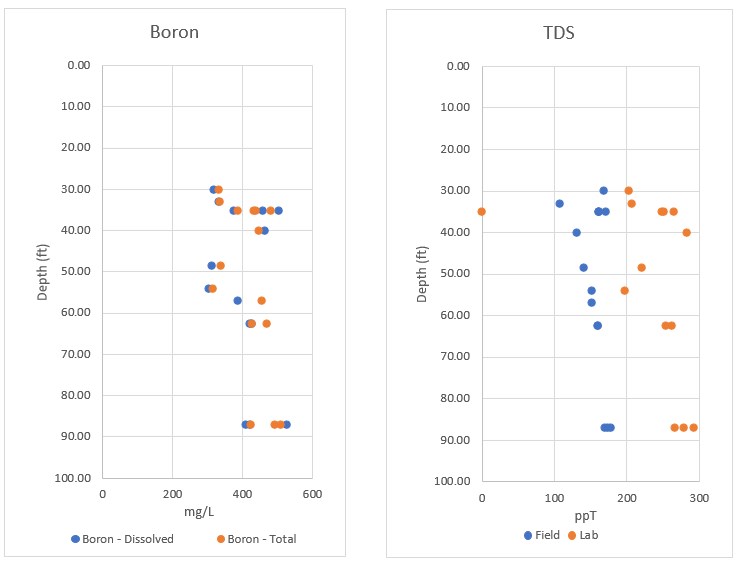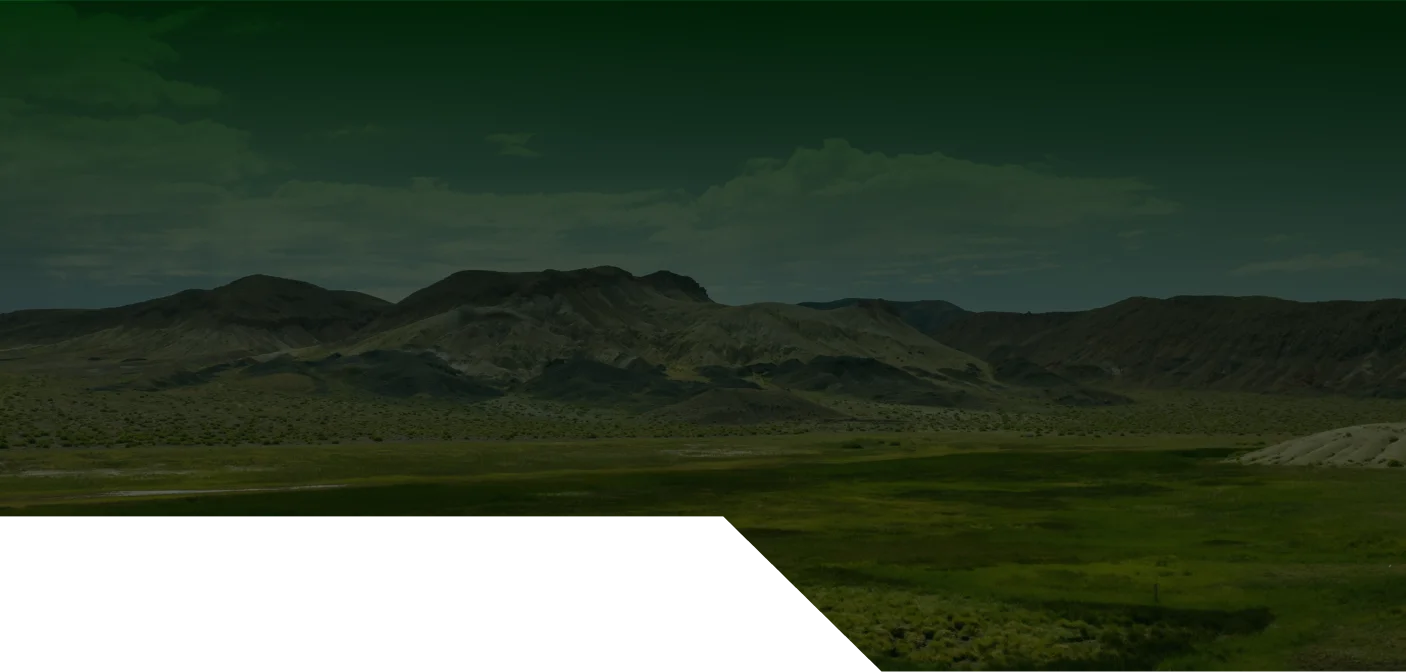Vancouver, British Columbia, June 3, 2024 – Canter Resources Corp. (CSE:CRC | OTC:CNRCF | FRA:601) (“Canter” or the “Company”) is pleased to report initial brine and clay/sediment assay results from the Company’s completed 15-hole Phase I shallow Geoprobe drill program at its Columbus Lithium-Boron Project (“Columbus” or the “Project”), located near Tonopah, Nevada. The assays reported herein correspond to approximately 35% of the samples collected during the program.
- Initial results successfully demonstrated mineralized brines from shallow aquifers over two kilometres in strike (“km”) highlighting the potential for multi-layered aquifers at Columbus.
- The initial sediment/clay samples returned peak values of 3,070 ppm boron (“B”), 690 ppm lithium (“Li”) and 3.89% potassium (“K”) with several highly mineralized sedimentary intervals starting from surface (see Table 2, Figure 1 for highlights). Clay results from CB24-018/019 highlight potential for higher grade Li-B mineralization to extend for kms to the west.
- Brine assay results returned notably significant boron values up to 508 milligrams per litre (“mg/L”), along with anomalous Li values up to 49.8 mg/L and high K values up to 5,870 mg/L (Total values – see Table 1, Figure 1-2 for more details).
“We are excited to see these boron-enriched brine concentrations and significant sedimentary intervals within the first ~30 metres along an extended strike length at Columbus,” stated Canter CEO Joness Lang. “Seeing boron enriched brines and lithium enriched clays in this shallow interval provides further proof-of-concept, supports our ongoing targeting, and speaks to the multi-commodity potential at Columbus. Boron production is currently limited to a few regions and operators globally and with boron applications rapidly advancing across our most critical growth sectors, including semiconductors and EVs, we view the potential to define significant boron mineralization, domestically, as a tremendous opportunity. We are just getting started with our phased drilling approach and look forward to more results from Phase I before probing deeper in subsequent campaigns set to commence in early Q3/2024.”
Highlighted Brine Results (Total values):
- CB24-012G: 454 mg/L B, 43.5 mg/L Li and 5,870 mg/L K at 17.37 m depth
- CB24-011G: 446 mg/L B, 41.2 mg/L Li and 5,030 mg/L K at 12.19 m depth
- CB24-012Gx: 468 mg/L B, 15.3 mg/L Li and 4,410 mg/L K at 19.05 m depth
- CB24-011Gx: 508 mg/L B, 2.8 mg/L Li and 4,110 mg/L K at 0.82 m depth
- CB24-013G: 337 mg/L B, 49.8 mg/L Li and 5,630 mg/L K at 14.63 m depth
Highlighted Clay Assay Results (Assays rounded – See Table 2):
- CB24-002G: 1,248 ppm B, 440 ppm Li and 2.7% K average over 25.15 m from surface
- Including 1,441 ppm B and 583 ppm Li over 13.0 m (up to 2,560 ppm B / 690 ppm Li)
- CB24-019G: 966 ppm B, 525 ppm Li and 3.4% K over 7.6 m (up to 1,530 ppm B / 630 ppm Li)
- CB24-018G: 2,106 ppm B and 343 ppm Li over final 4.3 m (up to 3,070 ppm B / 430 ppm Li)
- CB24-012G: 1,042 ppm B, 403 ppm Li and 2.66% K over 7 m (up to 1920 ppm B / 580 ppm Li)
Initial Observations and Interpretation of Results
A total of 15 shallow drill holes were completed to test the interpreted upper brine generation layer of the basin. The initial five drill holes (400 m spaced north-south grid) consistently intersected aquifers, capturing saturated brines at shallow depths over 2 km, returning significant near-surface boron-enriched brines and lithium-enriched clays, collectively providing support for the Company’s deeper brine targeting.
Figure 1: Zoomed in plan view highlighting brine (mg/L) and clay (ppm) total values for lithium and boron.The initial findings from the shallow drilling campaign highlight not only the substantial boron and lithium values, but also reveal the significant role of potassium and barium in influencing the geochemical environment. The Company views the potassium concentrations — as high as 5% in these assays — as playing a crucial role in maintaining lithium in solution due to ion exchange processes. This helps lithium remain mobile and migrate to deeper aquifers where it can concentrate in structural traps.
Anomalous boron values near surface are a commonly used pathfinder for targeting significant lithium concentrations deeper in a mineralized system, but the Company views the consistently elevated boron values in shallow brines and clays as very significant on a standalone basis. Boron brine concentrations ranged from 315 mg/L to 508 mg/L and averaged 417 mg/L across the initial brine results. Boron values (and total dissolved solids – “TDS”) also increased with depth (see Figure 2 below).
Figure 2: Comparison showing boron and TDS values increasing with depth. Historical assay data indicates boron values increase with depth within the upper levels of the basin and this new data corroborates this theory.Boron: Established Market, Emerging Applications & Strategic Importance
The boron market is rapidly emerging as a critical mineral due to its use in numerous high-tech and clean energy applications, making the presence of boron mineralization at Columbus potentially significant.
- The boron market is expected to grow to more than $3 billion USD by 2027¹, with Rio Tinto’s US Borax and Turkey’s state-owned Eti Maden producing an estimated 85% of global supply.²
- Ioneer’s ($300M USD market capitalization) claystone deposit hosts significant boron and shares the same volcanic source rocks as Columbus.
- Potential for significant boron concentrations at Columbus are considered excellent, with past borax brine production (late 1800s) and significant boron concentrations demonstrated in clays and brines from historical and now current drilling, respectively.
- The established boron market has been serving industrial sectors (ceramics, glass, agriculture and cleaning products) for a long time, however;
- The boron market is evolving and rapidly growing (currently more than 300 applications), including tech and clean energy, with significant amounts of boron in EVs, and super magnets created using boron being used in solar panels, nuclear reactors and wind turbines.
- A boron derivative has emerged as the best semiconductor material on earth, according to a recently competed study by researchers at MIT³.
To learn more about boron and its more than 300 applications, visit the Company’s Boron 101 webpage.
Table 1 – Highlighted Brine Sample Results
| Sample ID | Sample Depth (m) |
Total Sample Volume (mL) |
B Total mg/L |
B Dissolved mg/L |
Li Total mg/L |
Li Dissolved mg/L |
K Total mg/L |
K Dissolved mg/L |
| CB24-014G-33 | 10.1 | 350.0 | 336.0 | 331.0 | 10.8 | 2.5 | 4250.0 | 3820.0 |
| CB24-014G-54 | 16.5 | 350.0 | 315.0 | 303.0 | 4.4 | 4.0 | 3340.0 | 3090.0 |
| CB24-013G-30 | 9.1 | 350.0 | 331.0 | 316.0 | 2.5 | 2.1 | 3860.0 | 3750.0 |
| CB24-013G-48 | 14.8 | 350.0 | 337.0 | 312.0 | 49.8 | 2.3 | 5630.0 | 3510.0 |
| CB24-012G-35 | 10.7 | 350.0 | 385.0 | 375.0 | 2.7 | ND | 4410.0 | 4110.0 |
| CB24-012G-57 | 17.4 | 350.0 | 454.0 | 386.0 | 43.5 | 2.2 | 5870.0 | 3500.0 |
| CB24-012G-62.5x | 19.1 | 350.0 | 468.0 | 427.0 | 15.3 | 2.3 | 4410.0 | 4090.0 |
| CB24-011G-40 | 12.2 | 350.0 | 446.0 | 463.0 | 41.2 | 2.5 | 5030.0 | 4070.0 |
| CB24-011G-2.7x | 26.5 | 350.0 | 508.0 | 420.0 | 2.8 | ND | 4110.0 | 3270.0 |
| CB24-011G-18 | 26.5 | 350.0 | 425.0 | 409.0 | ND | ND | 3380.0 | 3210.0 |
| CB24-001G-35 | 10.7 | 350.0 | 480.0 | 458.0 | 2.8 | 2.4 | 4130.0 | 3850.0 |
Table 2 – Highlighted Clay Assay Results
| Hole_ID | From (m) | To (m) | Interval (m) | B (ppm) | Li (ppm) | K (%) |
| CB24-002G | 0.0 | 4.6 | 4.6 | 1670.0 | 301.2 | 2.7 |
| CB24-002G | 12.2 | 25.1 | 13.0 | 1440.6 | 583.0 | 2.6 |
| Peak Values | - | - | ~1.5 | 2560 @ 0 to 1.52m | 690 @ 19.8 to 21.3m | 3.02 @ 10.5 to 12.2m |
| Hole Average | 0.0 | 25.1 | 25.1 | 1247.6 | 440.0 | 2.7 |
| CB24-012G | 0.0 | 3.0 | 3.0 | 1435.0 | 263.2 | 2.6 |
| CB24-012G | 12.2 | 19.2 | 7.0 | 1042.4 | 403.0 | 2.6 |
| Peak Values | - | - | ~1.5 | 1920 @ 0 to 1.52m | 580 @ 16.8 to 18.3m | 3.06 @ 12.2 to 13.7m |
| Hole Average | 0.0 | 19.2 | 19.2 | 853.3 | 323.3 | 2.7 |
| CB24-014G | 9.1 | 15.2 | 6.1 | 735.0 | 282.9 | 2.8 |
| Peak Values | - | - | ~1.5 | 1190 @ 0 to 1.52m | 420 @ 19.8 to 21.3m | 3.01 @ 9.1 to 10.6m |
| Hole Average | 0.0 | 15.2 | 15.2 | 632.0 | 236.0 | 2.7 |
| CB24-018G | 4.6 | 8.8 | 4.3 | 2105.7 | 343.2 | 3.3 |
| Peak Values | - | - | ~1.5 | 3070 @ 7.6 to 8.8m | 430 @ 6.1 to 7.6m | 3.4 @ 4.5 to 6.1m |
| Hole Average | 0.0 | 8.8 | 8.8 | 1161.7 | 226.7 | 3.2 |
| CB24-019G | 4.6 | 12.2 | 7.6 | 966.0 | 524.9 | 3.4 |
| Peak Values | - | - | ~1.5 | 1530 @ 6.1 to 7.6m | 630 @ 10.6 to 12.2m | 3.9 @ 12.2 to 13.7m |
| Hole Average | 0 | 21.3 | 21.3 | 581.5 | 390.7 | 3.18 |
Disclaimer Note:
Mineralization at nearby or adjacent properties is not necessarily indicative of mineralization hosted at the Company’s Columbus Project.
Quality Assurance / Quality Control (QA/QC)
In a continued commitment to ensuring the highest standards of data accuracy and reliability, the Company has implemented a rigorous quality assurance and quality control (QA/QC) protocol for both groundwater and sediment sampling and analysis. This initiative is designed to enhance the precision and credibility of sampling techniques and assay results.
Upon reaching the target lithology depth during drilling, groundwater sampling is initiated with care to avoid surpassing the designated zone. Utilizing a drive-point screen sampler or mechanical bailer, groundwater is extracted to ensure a clean and uncontaminated collection process. Initial purging is conducted, and a Myron Ultrameter II is used to measure general parameters, such as temperature, pH, total dissolved solids (TDS), specific conductivity, and oxidation-reduction potential (ORP). For wet samples, a minimum 350 mL of groundwater is collected for comprehensive analysis, with all samples handled under strict chain of custody (COC) protocols and stored under optimal conditions until delivery to Western Environmental Testing (WETLAB).
The Company’s QA/QC procedures involve collecting additional samples every tenth sample, including duplicates, umpire, and blank samples, to validate the consistency and accuracy of the data. Laboratory analyses cover general parameters and both total and dissolved metals, adhering to stringent testing methods and holding times. More specifically, the following analysis is carried out at WETLAB: Density and pH: SM 4500-H+B; Temperature: SM 2550 B; Total Dissolved Solids (TDS): SM 2540 C; ICP Metals Total Li, B & K: EPA 200.7; Digestion for Total Metals: EPA 200.2; ICP Metals Dissolved Li, B & K: EPA 200.7; Digestion for Dissolved Metals: EPA 200.0 and Sample Filtration: SM.
Sediment samples are analyzed by ALS using the Analysis Method ME-ICP61, a four-acid digestion with ICP-AES finish. This method, while acquiring near-total values, may not quantitatively extract all elements in some sample matrices. It is suitable for intermediate-level lithium analysis in the exploration of Li-bearing sediments. To address boron loss during the four-acid digestion process, the Company includes the analysis of a single acid digestion (B-ICP41) to retain boron values. The Company is implementing a QA/QC protocol for sediment sampling to include Li and B CRMs sourced from Shea Clark Smith/MEG, Inc. and blank material.
Qualified Person (QP)
The technical information contained in this news release was reviewed and approved by Eric Saderholm P.Geo, Director and Technical Advisor of Canter Resources, a Qualified Person (QP), as defined under National Instrument 43- 101 – Standards of Disclosure for Mineral Projects.
About Canter Resources Corp.
Canter Resources Corp. is a Canadian junior mineral exploration company advancing the Columbus Lithium-Boron Project in Nevada, USA and the Beaver Creek Lithium Property in Montana, USA. The Company is completing a phased drilling approach at Columbus to test highly prospective brine targets at varying depths for lithium-boron enrichment and plans to leverage the Company’s critical metals targeting database to generate a portfolio of high-quality projects with the aim of defining mineral resources that support the domestic clean energy supply chain in North America.
For further information contact:
Joness Lang
Chief Executive Officer
Canter Resources Corp.
For investor inquiries contact:
Kristina Pillon,
High Tide Consulting Corp.
Tel: 604.908.1695
References
¹ Global Boron Market Report 2024
² Boron: The Overlooked Critical Material – Seeking Alpha 2022
³ The best semiconductor of them all? – MIT News Office – July 2022
The Canadian Securities Exchange has neither approved nor disapproved the contents of this news release. The Canadian Securities Exchange does not accept responsibility for the adequacy or accuracy of this news release.




